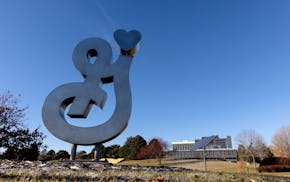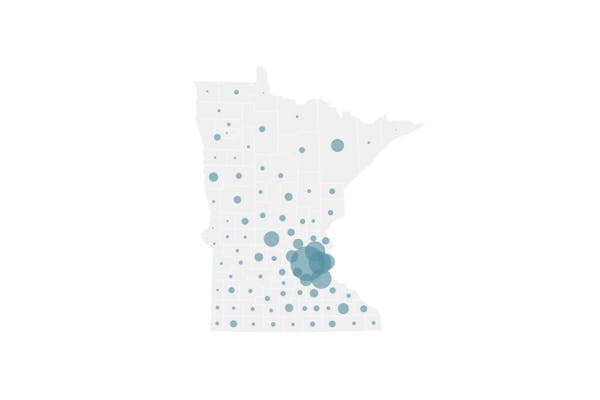The Mayo Clinic has begun rolling out a test to detect the virus that causes COVID-19, a development that comes as concerns build that a lack of testing capacity could thwart a robust response to the outbreak.
Mayo's large commercial lab in Rochester is one of several that have scrambled in recent weeks to create a test that can detect coronavirus in specimens. The lab says it started making tests available to health care providers at Mayo on Thursday and will open the supply to others in the coming days. Mayo's initial capacity of 200 to 300 tests per day is expected to grow in the coming weeks.
Creating a new test usually takes months or even a year, clinic officials say, but they opted to fast-track development of the new test beginning in mid-February after watching the virus overwhelm the health care system in China, where the outbreak strain of coronavirus originated.
"Trying to develop a test in a span of weeks is difficult," said Matthew Binnicker, director of the clinical virology lab at Mayo Clinic in Rochester. "We've been working diligently, around the clock."
Mayo Clinic Laboratories is a large commercial lab in Rochester that receives thousands of samples every day from clinics and hospitals around the world, not just from health care providers at Mayo's primary medical centers in Minnesota, Arizona and Florida. Last year, the lab completed about 25 million tests.
While Mayo is one of the largest hospital-affiliated reference labs, the much larger lab testing giants Quest Diagnostics and LabCorp also have launched coronavirus tests over the past week or so. A diagnostic also was developed by a company in Iowa called Integrated DNA Technologies, and the Cleveland Clinic said Thursday that it will soon have capabilities for on-site testing.
While President Donald Trump said late last week that anyone who needs a coronavirus test is getting one, others have raised doubts about the nation's supply and cited the much larger number of tests being performed in South Korea.
Dr. Scott Gottlieb, former commissioner of the Food and Drug Administration (FDA) in the Trump administration, said via Twitter on Thursday that the U.S. likely lost its chance for following South Korea's path in controlling the spread but must focus on averting the tragedy that's hitting Italy. One of the keys, Gottlieb wrote, is for commercial labs to dramatically expand the supply of coronavirus tests.
For weeks, Gottlieb has questioned the government's initial strategy to concentrate coronavirus testing at the Centers for Disease Control and Prevention (CDC) without also developing alternative sources. He wrote on Twitter in early February: "Since CDC and FDA haven't authorized public health or hospitals to run the tests, right now CDC is the only place that can. So, screening has to be rationed."
Initially, the FDA granted what's called an emergency use authorization only for the CDC's test for coronavirus, Mayo Clinic officials said. The decision meant that any other test developed by a lab or manufacturer would be required to go through an approval process, Mayo said, before it could be used for routine testing.
The federal government issued a new policy in mid-February as the demand for testing increased and stretched testing capacity at the CDC and state health labs. The new policy allowed certain clinical labs certified by the federal government to develop and validate their own tests, clinic officials said, and begin using them before FDA finished reviewing data.
Dr. William Morice, president of Mayo Clinic Laboratories, didn't comment on the CDC's initial strategy but noted that the coronavirus outbreak has quickly overwhelmed health care systems around the world.
"We heard what the federal government was telling us," Morice said. "We anticipated that this could potentially overwhelm the CDC's capacity to do the testing, so we chose to continue to develop the test."
Since mid-February, Mayo says it's had a team of 10 people working solely on test development, with work ranging from FDA data submissions to preparing the lab's system for accepting orders and returning results. About five team members have been focused on the actual testing and validation studies.
Lab workers have had to document the minimum level of virus that could be detected by the new test, as well as its effectiveness with samples taken from different parts of the body. They had to show how the Mayo test works compared with the CDC's test. And Mayo had to document the "specificity" of its test, to prove the diagnostic would identify patients infected with the current outbreak strain of the coronavirus, but not other viruses.
Whereas the U.S. initially centralized testing at the CDC, Morice said that China took the opposite approach by calling on many labs to develop diagnostics. As a result, some of the tests used early in China during the outbreak lacked specificity, he said, and provided false positives for the current outbreak strain, which scientists call SARS-CoV-2.
"People want to know if they have it," Morice said, "but they certainly don't want to get the wrong answer."
The development work was complicated not only by time pressure, but also by a limited supply of patient samples that could be used to validate the test.
Through collaboration with laboratories in states that are currently seeing more COVID-19 specimens, Mayo researchers could obtain excess samples that were positive for coronavirus but "blinded" in terms of patient information. They also used synthetic samples.
"You can't rush these things," Binnicker said. "You have to be very methodical."
With the new Mayo test, health care workers will use swabs to collect throat or nasal samples from patients and send the samples to Rochester for testing. Binnicker said via e-mail: "Due to limited initial testing capacity, the laboratory will use a scaled approach, with hopes of expanding capacity in the coming weeks. We will notify our health care partners around the country when capacity is available for their testing needs."
The coronavirus test adds to the repertoire of about 3,500 different tests conducted by Mayo Clinic Laboratories. The lab receives about 35,000 to 40,000 specimens per day. The total number of tests performed is higher because multiple tests can be performed on any given sample.
Samples come by way of the lab's signature berry-colored boxes, which typically start arriving early in the morning from a FedEx depot at the airport in Rochester. During a month's time, Mayo Clinic Laboratories receives shipments from 80 countries.
The new coronavirus test determines if viral RNA that's part of the coronavirus genome is present in samples. The testing technology is similar to that used in flu tests, Binnicker said, adding that he didn't have information on the price for the test.
"We need to make this available to patients and priced in a way that it can be performed for as many people as possible," Binnicker said. "This is more of a public health response than anything."
None of the companies developing the new tests released pricing information.
Lab companies have scrambled in the past to develop tests for detecting sudden outbreaks of Ebola, Zika and H1N1 influenza virus. Morice said leaders from several testing companies invoked the broader context during a meeting this month with Vice President Mike Pence, who is leading the Trump administration's response to the outbreak.
"This will not be the last time that this happens," Morice said.
Christopher Snowbeck • 612-673-4744
Twitter: @chrissnowbeck
Boston Scientific to cut jobs after discontinuing heart device

Congressional Dems including Omar ask judge to extend whistleblower case against UnitedHealth

Congressional budget bill could kill solar industry in Minnesota just as it was gaining momentum
Virtual reality has transformed design process for Eden Prairie-based Tennant

